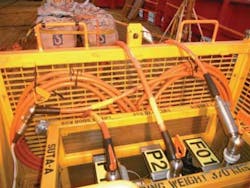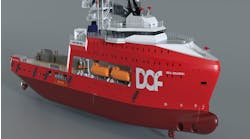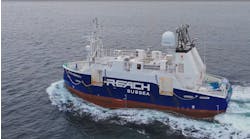Julie Boi
François Gooris
Antoine Marret
Technip
Active heating technologies can significantly help solve flow assurance issues from the subsea wellheads up to the surface support facilities, in particular when dealing with viscous fluids, long subsea tiebacks; and for circumstances when the flowing conditions at wellhead outlet (pressure, temperature, flow rate) are getting critical with respect to risks associated with hydrate and/or wax appearance.
In parallel with the development of heated flexible pipe designated IPB (integrated production bundle), Technip has developed and qualified a heated pipe-in-pipe technology using electrical heat trace cables installed in the annular space. Cables are in direct contact with the inner pipe and underneath a high performance thermal insulation, which globally affords this technology, designated ETH-PiP, a high heating efficiency.
This technology lends itself well to a large variety of applications, can enable and/or enhance cost-effective architectures for deepwater subsea developments. Moreover, the ETH-PiP can be combined with the IPB technology for the riser section, which then ensures a continuous heated flow path for the hydrocarbon transportation from the wellhead to a platform or FPSO.
The goal here is to review all the potential benefits the ETH-PiP technology can bring to a project, including potential capex and opex savings, compared to a conventional development based on passive insulation technologies.
Subsea challenges
Over the last decade, operators have faced new challenges in developing offshore oil and gas fields. Increasingly, these have turned from large concentrated resources and stand-alone host structures to more scattered fields with tie-in architectures to existing facilities or even to shore. The challenges of going deeper and longer, together with more challenging fluids (hydrates, wax, pour point, high viscosity), have led to requirements for highly insulated flowlines. Pipe-in-pipe technology has been demonstrated to be efficient with regard to flow assurance issues. But long tiebacks stretch conventional passive insulation to its limit, unless conventional loop architecture is adopted at prohibitive costs.
As an alternative and cost-effective solution, Technip developed an electrically trace heated solution for reeled pipe-in-pipe, and joined Total's qualification program in 2008. After more than two years of successful qualification, Total and its partners have considered the technology mature enough to allow the first application of the ETH-PiP technology on the Islay field in the North Sea.
The ETH-PiP working principle relies on the Joule resistive effect, which brings active heating through the three-phase electrical tracing cables. These cables end with a star connection where the three current phases sum is nil, and thus avoids the need for a current returning path, unlike other active heating technologies.
The main benefits of this configuration which separates the active heating system from the passive insulation system are:
Higher efficiency. The ETH-PiP is configured with tracing cables located in direct contact with the flowline and below the thermal insulation, which ensures maximum power transmission from the electrical cables to the fluid, thus minimizing heat loss. As a consequence, overall power consumption is kept very low and can easily be generated from existing topside facilities.
Better operability. The ETH-PiP technology delivers a continuous and uniform (longitudinal and circumferential) heating to the fluid. This allows the temperature to progressively increase until reaching equilibrium during warm-up transient phase, depending on the power being delivered and controlled from topsides.
First project application
In 2010, Total identified the Islay field development - a 6-km (3.7-mi) single well tieback to the existing Forvie subsea hub in the northern North Sea - as a potential candidate for a full scale subsea installation of the ETH-PiP technology. Technip was awarded the engineering, procurement, construction, and installation (EPCI) contract for the Islay project in March 2010. The ETH-PiP system's main characteristics include:
- 300% redundancy on the cables and connectors
- An overall heat transfer coefficient (OHTC) below 1 W/m².K
- A maximum power delivery of 30 W/m (for flowline warm up to 25°C within 24 hrs)
- A temperature monitoring system using fiber optics
- Power supply and control system to be provided as a mobile intervention unit which can be deployed from a vessel of opportunity for periodic system operational testing.
As part of the overall project delivery, an industrialization process of the ETH-PiP technology was carried out during the project phase. It has mainly focused on:
PiP standard components. Centralizers or spacers are used to restrain the flowline from coming into contact with the carrier during pipeline assembly, reeling, and installation. In order to accommodate the cables, slots had to be machined into the centralizers to allow cable continuity. Introducing slots required qualification testing to ensure the cables would not be damaged due to deformation of the slots in the centralizers under reeling loads or due to slippage during stalk assembly, reeling-on, or installation.
Splicing of electrical and fiber optic cables. Although electrical cable was considered fully qualified following the qualification program in 2009 and fiber optic technology was considered a proven technology, an optimization of the splicing for ETH-PIP application was necessary during the Islay project. The splice connections are required to join the cables between each of the ETH-PiP stalks during spooling or during repair operations. They not only need a high electrical or optical integrity but also a minimum size and easy assembly. Significant additional laboratory testing was performed to ensure both types of splice connections would be fit for purpose for the field life.
Fabrication and implementation. Another key consideration was fabrication and implementation on the pipeline fabrication line of the cable application machine (CAM). The CAM is the in-house designed machine used to spiral the cables on the flowline during the PiP fabrication. The CAM was fabricated in Poland using Technip's experience in flexible pipeline manufacturing, then installed on the fabrication line of the Evanton spoolbase in Scotland, UK, used to construct standard PiP. The main optimization of the CAM post-installation was the incorporation of a continuous-cable monitoring system measuring the continuity resistance in order to ensure that the cables being installed on the flowline remained in a good condition throughout the application process. Fiberoptic integrity was also continuously monitored during spiraling.
Termination assembly. This is the unit providing electrical and optical connection interface between the subsea environment and the dry PiP annulus through the wet mateable connector. In order to facilitate the connection of the cables within the ETH-PiP to the power supply and control intervention system, a gun barrel design was developed during the project. It presents a dual barrier between the subsea environment and the dry PiP annulus to prevent water leakage. It also has a compact design which facilitated the subsea installation performed with the Apache II vessel.
Power system design. In order to provide power to the system, as well as provide control and a mean to process the temperature data being transmitted along the fiberoptic cables, a topside intervention system was designed and constructed. This system is fully contained within a standard 20 ft offshore container and also houses the equipment required to provide sufficient power. In addition the system includes the Distributed Temperature Sensing (DTS) processing equipment which processes and reports the temperature of the pipeline during operation of the ETH system or during transient phase. The connection between topsides and ETH-PiP is made via a standard subsea umbilical and connected flying leads.
The successful industrialization of all these critical components has led to the successful installation of the first ETH-PiP on Islay in January 2012.
The pre-commissioning tests were performed following the pipeline installation. Upon electrical and optical testing to demonstrate its integrity post-installation, one cable was used to heat the line at 30 W/m: the temperature rose from 4 to 17°C in less than 7 hrs. The temperature profile obtained provided a good match with the CFD heating curves.
The production started in February 2012 with the first planned shutdown in September. During the September shutdown, the intervention system was mobilized and deployed on the field for integrity and heating testing. This time, two cables were used for heating the pipeline over a large range of heating rates. Data from these integrity and heating performance tests confirmed the preliminary test results observed during the post-installation phase in April.
Long subsea tiebacks
Long subsea tiebacks have become a preferred solution to reduce initial investment in new host facilities. The maximum achievable tieback distance is dictated by the reservoir and fluid properties; for example wellhead pressure and temperature may be low and fluid characteristics may be difficult with high viscosity or wax content making preservation and start-up operations critical.
One recent case study addresses the potential benefits of the ETH-PiP on a typical long tieback application, and demonstrates how flow assurance and operability issues can be solved with this technology.
In this example, an OLGA model was built to represent a typical 30-km (18.6-mi) long tieback from a wellhead at around 800-m (2,624-ft) water depth to an existing FPSO at around 300-m water (984-ft) depth.
The flow assurance conditions determined using the OLGA model have shown that the topsides arrival requirements (pressure and temperature) were met during steady-state production in order to remain above the hydrate appearance threshold for any of the considered field production case.
The model was built considering the following assumptions on the ETH-PiP flowline design:
- Overall heat transfer coefficient = 1 W/(m².K)
- Wellhead flowing temperature = 50°C
- Hydrate appearance threshold = 25°C.
During steady-state production, the passive thermal performance of the ETH-PiP allows normal production without any requirement for heating the fluid. Therefore, active heating is only necessary during transient phase in order to maintain the fluid above the HAT and allow for quickly warming the fluid during restart phase.
A 3D CFD model using FLUENT software was used to determine the heating requirement needed during transient phases to maintain the fluid temperature above HAT and to perform warm-up operation from 5°C to 25°C, assuming the most stringent case, i.e. the flowline full of water, which has the highest thermal inertia.
The electrical design and cables arrangement selection in the ETH-PiP technology relies on the following criteria:
- Voltage limitation on the cables
- Warm-up duration
- Redundancy philosophy.
The selection of the number of heat tracing cables installed in the annular space of the ETH-PiP is based on the power requirement determined by the CFD simulations and the maximum voltage that can be sustained by the cables. For the currently qualified second generation cables, the voltage limitation allows for a maximum power of 35 W/m for a 30-km long subsea tieback.
Results from the CFD simulations show that maintaining the temperature above WAT for this 30-km tieback can be achieved with a linear power of around 25 W/m, far below the maximum limitation of the cables. Maintaining the fluid above HAT during transient phase can thus be achieved with only one trace cable, however warm-up operation has demonstrated to be much faster when applying 50 W/m with two trace heating cables.
When considering that warming-up the fluid with two trace cables represents the most stringent condition for this example, a certain level of redundancy should be adopted in order to ensure that this requirement on the minimum number of operating cables is met over the entire field life. The required level of redundancy for the Islay project on the tracing system was 300%. Thus, the same value was considered for this case study which led to a number of six trace cables installed in the annular space of the ETH-PiP, in this example.
With regards to the electrical feeding of the ETH-PiP, it has been shown that warming the fluid at 50 W/m with two cables is the most power-consuming phase for the cases addressed in this study. This linear power requirement leads to an overall power of 1.5 MW to be produced for feeding the heat trace cables, which can easily be done from topsides power generation with an appropriate transformer and a dedicated subsea umbilical connected subsea to a ROV panel. Final design of the topsides power generator should also account for the voltage drop in the power umbilical and the transformer efficiency which leads, with margin, to an overall topside power consumption of 1.8 MW.
The implementation of active heating on long subsea tiebacks provides the same advantages as for infield developments, i.e. a reduction of the number of risers and removal of half the pipe length, which has a massive impact on capex, especially when corrosion resistant alloys (cladding or massive) are used.
Unlike other active heating technology based on direct electrical heating, ETH-PiP allows operators to keep power requirements low, and thus has a minimum impact on the surface support infrastructure. The opex will consequently be lower due to this minimized power consumption as well as the lower requirement for chemical injection.
Way forward
Technip is investigating a new subsea integrated approach which combines its active heating solutions, i.e. ETH-PiP and IPB, with subsea processing technologies to optimize field architecture. Indeed a field which can benefit from a subsea processing scheme could also take advantage of heated pipeline technology, especially in case of challenging flow assurance conditions.
Subsea processing has been used in recent years either to enable or enhance offshore projects economics. Subsea boosting, gas/liquid and liquid/liquid separation, and gas compression are now building blocks that are part of the subsea toolkit that allow operators to optimize their subsea developments in term of cost, schedule, production profiles, and ultimate recovery.
For long subsea tiebacks of waxy oil, process and flow assurance studies show that combining a subsea separation and boosting station to an active heating solution is valuable. The actual rate of maturity on subsea process units does not allow implementation on long subsea tiebacks due to the stringent requirements in separation level and/or boosting of multi-phase fluids. The addition of an active heating solution either for flowline only or for flowline and risers (ETH-PiP and IPB) would relax the design constraints of the subsea separation and boosting units to prevent hydrates and/or wax appearance conditions.
In contrast, the use of subsea processing reduces active heating requirement from 40 to 60% in case of continuous heating during production.
Installing the subsea processing station at the riser base with gas free flowing to the host has advantages. These include minimizing the separator operating pressure, minimizing slug issues in the gas riser, and reducing the power and control umbilical lengths.
This integrated configuration affords other valuable benefits such as:
- Improved oil recovery thanks to the reduction of the wellhead back pressure
- Greater flexibility of preservation strategy (depressurization via the gas riser, facilitated restart with warmed up lines)
- Ease of riser operation in ultra-deep water (widening the operating envelop)
- Reduction of heat requirement in the riser due to multi-phase fluid temperature increase through the pump
- Electrical power distribution synergies between the subsea pump and the active heating.
This integrated approach can be deployed even further when trying to optimize a subsea development with (for instance):
- Water removal and reinjection to reduce active heated flowline diameters, heat loads, and topsides water treatment requirements
- Wet gas compression and transportation via active heated lines with minimum hydrate inhibitor injection.
Conclusions
ETH-PiP's equipment qualification and industrialization process have led to the successful first application of the technology on Total's Islay field. This demonstrates the interest of operators in using active heating, which enables some field developments and/or simplifies the operating procedure thanks to a more flexible and fit-for-purpose system.
In addition, current developments will allow going beyond the actual tracing cables limitation and will make this technology even more suitable for marginal field development, long subsea tieback, or simply reducing capex and opex compared to other conventional solutions by:
- Limiting capex compared to a conventional loop development
- Limiting capex with regard to topsides equipment/less constraints on existing host facility
- Limiting opex due to minimized chemical injection
- Improving operability due to longer no-touch time and faster restart
- Improved oil recovery due to reduction in fluid's viscosity by heating
- Potential field life extension.
It is believed that the technical advantages brought by active heating technologies, i.e. ETH-PiP and IPB, as well as the capex and opex savings, can be further increased when combined with subsea processing systems.
Technip is investigating these synergies in order to propose new integrated field development which will extend the effectiveness and range of application of such a combination and thus enable unlocking reserves or developing complex long subsea tiebacks in an economic manner.
Acknowledgment
Based on a paper presented at the Deep Offshore Technology International conference held in Perth, Australia, Nov. 27-29, 2012.
Offshore Articles Archives
View Oil and Gas Articles on PennEnergy.com








